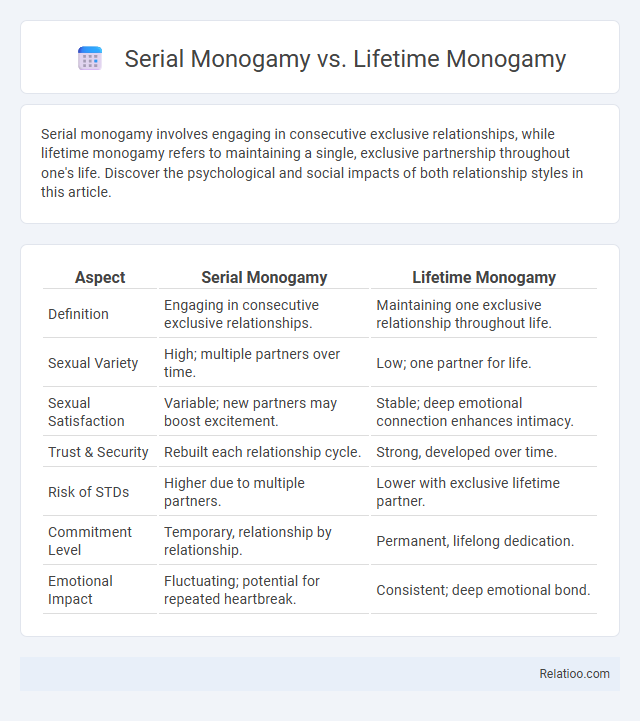Serial monogamy involves engaging in consecutive exclusive relationships, while lifetime monogamy refers to maintaining a single, exclusive partnership throughout one's life. Discover the psychological and social impacts of both relationship styles in this article.
Table of Comparison
| Aspect | Serial Monogamy | Lifetime Monogamy |
|---|---|---|
| Definition | Engaging in consecutive exclusive relationships. | Maintaining one exclusive relationship throughout life. |
| Sexual Variety | High; multiple partners over time. | Low; one partner for life. |
| Sexual Satisfaction | Variable; new partners may boost excitement. | Stable; deep emotional connection enhances intimacy. |
| Trust & Security | Rebuilt each relationship cycle. | Strong, developed over time. |
| Risk of STDs | Higher due to multiple partners. | Lower with exclusive lifetime partner. |
| Commitment Level | Temporary, relationship by relationship. | Permanent, lifelong dedication. |
| Emotional Impact | Fluctuating; potential for repeated heartbreak. | Consistent; deep emotional bond. |
Understanding Serial Monogamy and Lifetime Monogamy
Serial monogamy involves engaging in a series of exclusive, long-term relationships one after another, allowing individuals to experience multiple committed partnerships throughout their life. Lifetime monogamy refers to maintaining a single, lifelong exclusive partnership without engaging in other romantic relationships. Understanding these distinctions helps you navigate different relationship models and choose the one that aligns best with your values and emotional needs.
Historical Origins of Monogamous Practices
Monogamous practices have evolved through various cultural and historical contexts, with serial monogamy emerging as a modern adaptation allowing individuals to have multiple sequential long-term partners. Lifetime monogamy, the traditional ideal, traces back to ancient societies emphasizing social stability, inheritance, and religious doctrines that promoted lifelong pair bonds. Your understanding of monogamy is enriched by recognizing how historical origins shaped these distinct relationship patterns, reflecting changing social norms and economic structures.
Psychological Motivations Behind Relationship Choices
Psychological motivations driving your choice between serial monogamy, lifetime monogamy, or general monogamy often revolve around attachment styles, fear of abandonment, and desire for emotional security. Individuals favoring serial monogamy tend to seek new emotional experiences to fulfill evolving personal needs, while those committed to lifetime monogamy prioritize stability and deep-rooted emotional bonds. Understanding these motivations reveals how your personal values and past relationship experiences shape your monogamous preferences.
Societal Influences on Monogamy Styles
Societal norms and cultural values heavily influence the prevalence of serial monogamy, lifetime monogamy, and general monogamy in communities worldwide. Economic factors, religious beliefs, and legal frameworks shape your relationship choices by dictating acceptable union patterns and commitment durations. Understanding these societal influences can help you navigate and make informed decisions about your own monogamous style.
Emotional Impact: Serial vs Lifetime Monogamy
Serial monogamy often brings fluctuating emotional highs and lows due to repeated relationship cycles, which can foster resilience or emotional fatigue over time. Lifetime monogamy tends to provide stable emotional security and deeper attachment, reducing stress but potentially limiting interpersonal growth. Both forms of monogamy impact mental health and emotional well-being differently, influenced by individual personality traits and relationship quality.
Implications for Family Structure and Child-Rearing
Serial monogamy, characterized by successive exclusive relationships, often leads to blended family structures where children may experience multiple parental figures, potentially affecting emotional stability and continuity in caregiving. Lifetime monogamy emphasizes a single, lifelong partnership that typically provides consistent family environments and stable parental involvement, fostering secure attachment and predictable support systems for child-rearing. General monogamy, as a broader concept, prioritizes exclusive pair-bonding but varies in practice, significantly influencing family dynamics and child development outcomes based on relationship duration and stability.
Sexual Satisfaction and Relationship Longevity
Serial monogamy involves engaging in successive exclusive relationships, often enhancing sexual satisfaction through novelty and varied experiences while potentially affecting relationship longevity due to repeated adjustments. Lifetime monogamy emphasizes a single, enduring partnership that fosters deep emotional intimacy and stable sexual satisfaction, contributing to prolonged relationship stability. Understanding these distinctions can help you evaluate how sexual fulfillment and long-term commitment align with your relationship goals.
Modern Trends in Monogamy: Statistical Insights
Modern trends in monogamy reveal a growing preference for serial monogamy, with studies showing that approximately 45% of adults experience multiple monogamous relationships over their lifetime, compared to about 36% in lifetime monogamy. Research indicates that serial monogamy often reflects changing social norms and an increased acceptance of relationship transitions, while strict lifetime monogamy remains less common in contemporary societies. Understanding these trends can help you navigate relationship expectations within the evolving landscape of monogamous practices.
Cultural Perspectives on Monogamy Variations
Cultural perspectives on monogamy reveal significant variations, with serial monogamy often embraced in Western societies emphasizing individual choice and relationship cycles, while lifetime monogamy remains prevalent in traditional cultures valuing long-term commitment and social stability. Monogamy itself, defined broadly as having one partner at a time, adapts within diverse cultural frameworks influencing your understanding of relationship norms. These cultural variations shape expectations, rituals, and social acceptance, reflecting broader societal values and historical contexts around partnership and fidelity.
Choosing What Works: Personal Alignment and Fulfillment
Serial monogamy involves engaging in successive exclusive relationships, while lifetime monogamy entails maintaining a single partner throughout life, and monogamy generally refers to exclusive partnership at any given time. Choosing between these relationship styles depends on individual values, emotional needs, and long-term goals, highlighting the importance of personal alignment for sustainable fulfillment. Prioritizing self-awareness and open communication enables individuals to select a monogamy pattern that supports their happiness and relationship satisfaction.

Infographic: Serial Monogamy vs Lifetime Monogamy
 relatioo.com
relatioo.com